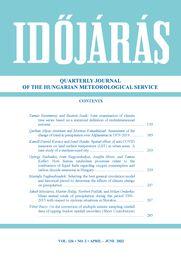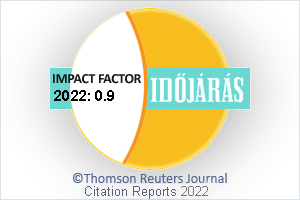Időjárás - Quarterly Journal of the Hungarian Meteorological Service (OMSZ)
Vol. 126, No. 2 * Pages 159–295 * April - June 2022
 |
|
 download [pdf: 2821 KB]
download [pdf: 2821 KB]
Joint examination of climate time series based on a statistical definition of multidimensional extreme
Tamás Szentimrey and Beatrix Izsák
DOI:10.28974/idojaras.2022.2.1 (pp. 159–184)
Tamás Szentimrey and Beatrix Izsák
DOI:10.28974/idojaras.2022.2.1 (pp. 159–184)
Assessment of the change of trend in precipitation over Afghanistan in 1979–2019
Qurban Aliyar Assistant and Morteza Esmailnejad
DOI:10.28974/idojaras.2022.2.2 (pp. 185–201)
Qurban Aliyar Assistant and Morteza Esmailnejad
DOI:10.28974/idojaras.2022.2.2 (pp. 185–201)
Spatial effect of anti-COVID measures on land surface temperature (LST) in urban areas: A case study of a medium-sized city
Kamill Dániel Kovács and Ionel Haidu
DOI:10.28974/idojaras.2022.2.3 (pp. 203–232)
Kamill Dániel Kovács and Ionel Haidu
DOI:10.28974/idojaras.2022.2.3 (pp. 203–232)
How human catabolism processes relate to the combustion of liquid fuels regarding oxygen consumption and carbon dioxide emissions in Hungary
György Szabados, Iván Nagyszokolyai, Jozefin Hézer, and Tamás Koller
DOI:10.28974/idojaras.2022.2.4 (pp. 233–246)
György Szabados, Iván Nagyszokolyai, Jozefin Hézer, and Tamás Koller
DOI:10.28974/idojaras.2022.2.4 (pp. 233–246)
Selecting the best general circulation model and historical period to determine the effects of climate change on precipitation
Mostafa Yaghoobzadeh
DOI:10.28974/idojaras.2022.2.5 (pp. 247–265)
Mostafa Yaghoobzadeh
DOI:10.28974/idojaras.2022.2.5 (pp. 247–265)
Mean annual totals of precipitation during the period 1991–2015 with respect to cyclonic situations in Slovakia
Jakub Mészáros, Martin Halaj, Norbert Polčák, and Milan Onderka
DOI:10.28974/idojaras.2022.2.6 (pp. 267–284)
Jakub Mészáros, Martin Halaj, Norbert Polčák, and Milan Onderka
DOI:10.28974/idojaras.2022.2.6 (pp. 267–284)
On the correction of multiple minute sampling rainfall data of tipping bucket rainfall recorders (Short Contribution)
Tibor Rácz
DOI:10.28974/idojaras.2022.2.7 (pp. 285–295)
Tibor Rácz
DOI:10.28974/idojaras.2022.2.7 (pp. 285–295)
IDŐJÁRÁS - Quarterly Journal

Az IDŐJÁRÁS a HungaroMet Nonprofit Zrt. negyedévenként megjelenő angol nyelvű folyóirata
Megrendelhető a journal.idojaras@met.hu címen.
A szerzőknek szánt útmutató itt olvasható.
Megrendelhető a journal.idojaras@met.hu címen.
A szerzőknek szánt útmutató itt olvasható.









